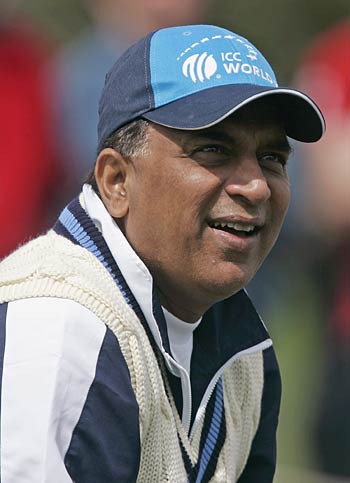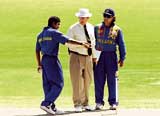
|

Gavaskar's salvo against Ponting may have been a bit of pre-World Cup sledging in the time-honoured Aussie tradition
© Getty Images
|
|
It appeared the ultimate contrived controversy. As the 2007 World Cup began, Sunil Gavaskar and Ricky Ponting got into a slanging match. Gavaskar accused the Australians of being a badly behaved bunch, and contrasted them with the West Indies team of the 1980s, apparently fair-playing "popular winners". What took things a trifle too far was Gavaskar's remark that Australian players were so foul-mouthed they were a walking invitation to bar-room brawls. He referred to the late David Hookes, a cricketer who died after a fracas outside a bar.
The Hookes allusion was decidedly tasteless. It left Gavaskar open to charges of (reverse) racism, and of taking his baiting of Anglo-Australian cricketers to an extreme. How would Indians have reacted if, for instance, Allan Border had told the media that he was worried Indian cricketers would get carried away after an on-field argument, given what road rage had pushed Navjot Sidhu towards?
In the event, Gavaskar eventually apologised after an outcry from former Australian players. But just what was he getting at? How much of what he said was genuinely heartfelt, how much was just plain pre-tournament gamesmanship and needling, and how much actually indicated the undercurrents of racism in international sport? Most important - or perhaps least important - was he right in exonerating Clive Lloyd's brigade as good sports who shone in comparison to the "Ugly Australians": Caribbean Tom Brown versus antipodean Flashman?
Take one issue at a time, beginning with Gavaskar's never-ending, and frankly tiresome, war with the Anglo-Australian cricket world.
Sunny bays
Justifiably or otherwise, the former Indian captain carries a number of chips on his shoulder. In some ways he hasn't forgotten umpire Rex Whitehead ruling him out leg-before at Melbourne in 1981, or forgiven Dennis Lillee for pointing a finger, calling him a four-letter word, and asking him to get going to the pavilion.
There are other slights, too, that refuse to rest in peace. Gavaskar still pokes fun at the stuffy nature of the English establishment and the MCC, possibly because he was once refused entry to Lord's by an official who didn't recognise him.
In 2001 when the English team came to India, Gavaskar accused them of playing "boring" cricket to avoid defeat. This again seemed odd, given the man's own history. Was this the captain who, having won the first Test against Keith Fletcher's England side on a minefield of a wicket, relentlessly pursued dull draws for the rest of the series? In one Test, Gavaskar took nearly 12 hours to reach 172. Wasn't he being "boring" and playing for a draw?
So what's driving Gavaskar? Obviously the effect is more important to him than the content. As he has often told associates, he is alert - over-alert, some would suggest - to the mental games played by the Australians especially. These usually begin with, a co-commentator recalls Gavaskar describing almost avidly, a senior player or even a former star - but rarely the current captain - making some gratuitous statement or the other about how weak or pitiful the opposition is. This needles the rival team or puts pressure on a key player, and furthers the process of what Steve Waugh so eloquently termed "mental disintegration".
Was Gavaskar trying to do the same thing to the Australians, an ageing side with a patchy recent record in one-day cricket, just before the biggest limited-overs tournament of them all? At least Glenn McGrath thought so, in a remarkably mature assessment that essentially said: If he thinks we're badly behaved, that's his problem. Just keep David Hookes out of it.
Is old gold?
Second, move to the comparison between the Waugh-Ponting Australian team and the Lloyd-Viv Richards era West Indians. Nostalgia has a strange way of dulling emotions, but it would be sobering to recall that Lloyd's team were often criticised by their opponents for slow over-rates; for a cynical, bouncer-happy approach; for aiming at the tailender's cheek bone; for sheer intimidation.
In the 1983 Prudential Cup final, Balwinder Sandhu, batting courageously at No. 11 after a middle-order collapse, was hit on the helmet by Malcolm Marshall. "Bouncing the No. 11... not on," said an English commentator, shaking his head.
 It would be sobering to recall that Lloyd's team were often criticised for slow over-rates; for a cynical, bouncer-happy approach; for aiming at the tailender's cheek bone
It would be sobering to recall that Lloyd's team were often criticised for slow over-rates; for a cynical, bouncer-happy approach; for aiming at the tailender's cheek bone

|
It was a more virulent manifestation of this impulse that left India with half their batting order injured at Kingston in 1976, and no one to bat after the fifth wicket fell. This had a certain Sunil Gavaskar tearing into the West Indies - team, spectators, and society - in his book
Sunny Days.
Go back to another story from the winter of 1983. Played on a breaking wicket, the Ahmedabad Test was evenly poised till Lloyd took "extra-constitutional" measures. In his newspaper column Lloyd lit into the umpires, calling them biased, prejudiced, disgraceful, and worse. It worked. When play resumed, the gentlemen in white coats were clearly nervous, and prone to giving the visitors more benefits than there were doubts.
Was Lloyd being unsportsmanlike or uncivil? By one reckoning, he was doing nothing wrong at all. In sport, teams and individuals play to win, not be recognised as honourable schoolboys. A lot of people like Vijay Amritraj, a far greater number remember John McEnroe. That is why, even if Indians may have brushed it aside as irrelevant, Ponting's cutting remark that Gavaskar may want to consider the Indian team's recent record told a story of its own.
Cricket, colour-coded
Was Douglas Jardine racist? If you do a pop quiz among Indian cricket buffs, the overwhelming verdict, nine to one, would be, "Yes, yes, of course." Jardine, protagonist of Bodyline, famously hated Australians and once called them an "uneducated and... unruly mob". Perhaps he was classist too: an Oxford-educated patrician who thought nothing of using a strongly-built coal miner, Harold Larwood, to implement his grotesque "leg theory", and then let that hapless bowler carry the burden of guilt.
Yet what was India's experience with Jardine in 1933-34, when he came here for a series in the winter following Bodyline? In Bombay, the city of his birth, Jardine made an effort to trace and visit his parents' old and ailing butler - a small but touching gesture that no Australian, certainly, would have expected of the MCC captain.
Next, read what Lala Amarnath has to say about the captain of the fielding side when he hit India's first Test century at the Bombay Gymkhana. This extract from The Making of a Legend: Lala Amarnath, Life and Times is illustrative: "When I completed the single to reach my century, CK Nayudu touched his bat at the crease and walked down the pitch to shake hands and congratulate me. Since the ball was still in play, the throw landed in the wicketkeeper's gloves with CK out of the crease. The wicketkeeper, Elliot, looked at his captain for his approval to run the Indian skipper out, but the English captain disapproved with a gesture. It was a wonderful display of true sporting spirit."

|

Muralitharan and Ranatunga discuss the definition of a no-ball with umpire Ross Emerson at Adelaide in 1999
© Getty Images
|
|
Race, nationalism, parochialism, identity - no area of human endeavour is free of conflicts devolving around these, and there is no reason why cricket should be the singular exception. Yet it would be important to note that for every determined and proven theory of racism, there is an equal and opposite theory.
Indian cricket fans often argue that the Australians and the South Africans - consistently, the two best white teams in the world - don't understand or appreciate subcontinental social niceties; that they can't figure out why the prototypical Indian or Pakistani or Sri Lankan cricketer is so strait-laced, mild-mannered, and diffident, rather than a matey pub-hopper with a redoubtable vocabulary of cuss words. They are nonplussed that somebody like Muttiah Muralitharan has taken Australian sledging to heart.
Yet there is the other side of the story. So used are cricket's "traditional" cultures to the deferential, goody two-shoes demeanour of subcontinental cricketers that when an Arjuna Ranatunga stands up for his beleaguered spinner and fights the umpires and the Australian media, when Sourav Ganguly writes a little script of his own and keeps Steve Waugh waiting for the toss, when Imran Khan says he has no patience for Ian Botham and Allan Lamb because they are not in his class, there are howls of protest; it is not laughed away or grudgingly appreciated as clever gamesmanship.
Sometimes there are overt double standards too. In 1996 the Australians famously boycotted the Sri Lanka leg of the World Cup, claiming to be worried about Tamil Tiger violence. After 9/11, with greater reason perhaps, they opted out of a tour of Pakistan and played instead in "neutral" Colombo and Sharjah. Yet in July 2005, when terrorist bombings shook London, there was no question or serious talk of not playing the first Ashes Test at Lord's two weeks later.
Having said that, how much do "coloured" cricket societies do to keep the stereotypes alive? It is easy to admonish Australian aggression as overdone, but name the cricket journalist in India who has not written long essays bemoaning India's lack of Aussie-style steel. As Indian coach, Greg Chappell has been asked by a dozen interviewers as to how he plans to inculcate "Australian aggro" into the Indian team. To be fair to him, he has not taken the question seriously.
The fact that it is asked, however, does point to the obverse side of excessive sensitivity to racism - that it sometimes betrays an inferiority complex. That's another pitch, to be tackled another day.
Ashok Malik is a writer based in New Delhi

